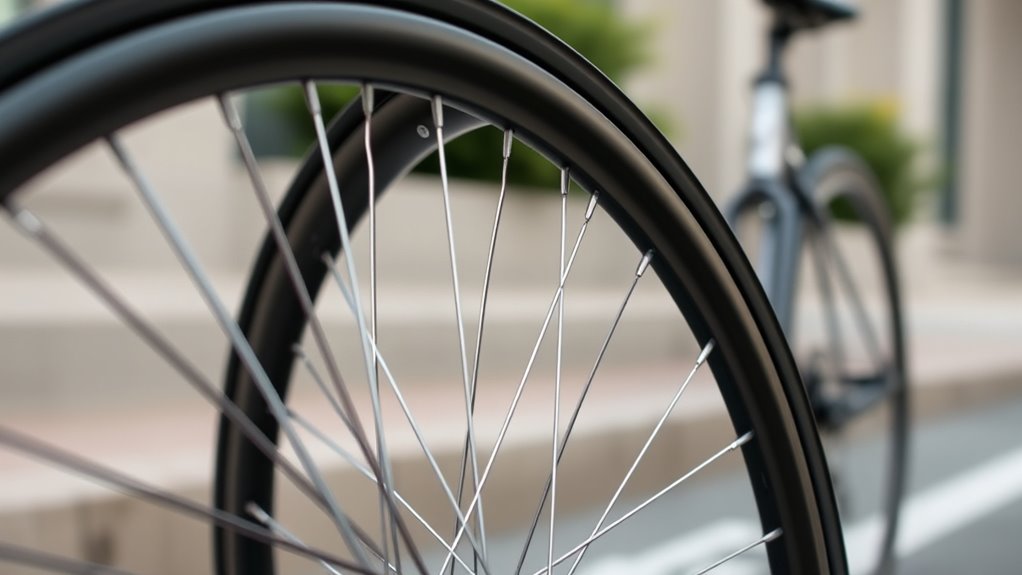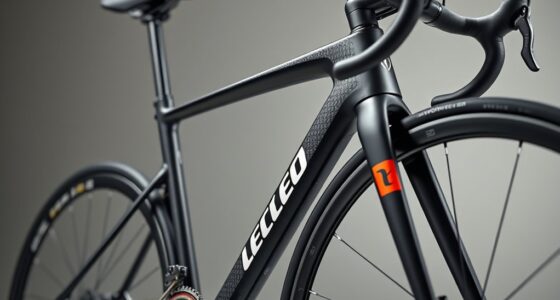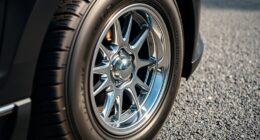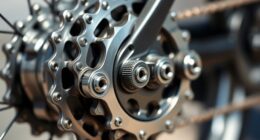Hookless rims have a smooth profile without the traditional hook edge, which means you need tires specifically designed for them. Make certain your tires are labeled as compatible to ensure safe, secure seating and reduce blowout risks. These rims rely on strong materials like carbon or aluminum for durability and require careful installation to prevent damage. Want to know more about choosing the right tires and maintaining your hookless wheels? Keep exploring to learn all the essentials.
Key Takeaways
- Ensure tires are specifically labeled as compatible with hookless rims to guarantee proper seating and safety.
- Hookless rims rely on strong construction and materials like carbon fiber or aluminum for durability and impact resistance.
- Proper installation and inflation techniques are essential to prevent tire blow-offs and rim damage.
- Understand that hookless rims may have different strength and fatigue ratings compared to traditional hooked rims.
- Regularly check manufacturer recommendations and maintain rims to ensure safe, reliable riding performance.

Hookless rims are increasingly common in modern cycling, and understanding their design can help you make better decisions on the bike. Unlike traditional hooked rims, which feature a small hook or bead seat that holds the tire securely in place, hookless rims have a smooth, straight-edged profile. This design simplifies manufacturing and can reduce weight, but it also impacts tire compatibility and rim strength. As a rider, knowing these differences helps you select the right tires and guarantees your wheel’s durability.
Hookless rims have a straight-edged profile that affects tire compatibility and rim strength.
When it comes to tire compatibility, hookless rims typically require specific tire beads designed for this profile. Not all tires work seamlessly with hookless rims, especially older or traditional types with hooks. You need to look for tires labeled as compatible with hookless rims, which usually have a bead that fits the straight-edged rim profile securely. Using incompatible tires can lead to poor seating, increased risk of blowouts, or even tire blow-offs under high pressure or during aggressive riding. It’s crucial to check the manufacturer’s recommendations and verify the tire’s bead profile matches the rim to avoid safety issues and optimize performance.
Rim strength is another critical consideration with hookless designs. The absence of a hook means that the rim relies heavily on its overall material and structural integrity to withstand forces during riding. Modern hookless rims are often made from high-strength carbon fiber or aluminum, but their durability depends on the quality of construction and the riding conditions. Because there’s no hook to distribute tension evenly, the rim must be robust enough to handle impacts, heavy loads, and high pressures. If you ride aggressively or frequently encounter rough terrain, you should pay close attention to the rim’s ratings for strength and fatigue resistance.
Additionally, the development of hookless rims has led to innovations in rim construction, making them more resistant to impacts when properly designed. Furthermore, the transition from a hooked to a hookless rim can influence how you approach maintenance and repairs. For example, when installing new tires, you might find it easier to mount them without the need for hooks, but you’ll need to be cautious about seating the bead correctly. Proper inflation and careful installation are essential to prevent bead blow-offs or rim damage. In addition, when considering upgrades or replacements, understanding the rim’s strength and compatibility guarantees you don’t compromise safety or performance. Overall, selecting the right tires and recognizing the importance of rim strength helps you get the most out of your hookless wheelset while maintaining safety and reliability on the road or trail.
Frequently Asked Questions
Are Hookless Rims Compatible With All Tire Types?
Hookless rims are not compatible with all tire types. You need to check tire compatibility carefully, as some tires are designed specifically for hookless rims while others require hook bead rims. Rim flexibility also plays a role; more flexible rims can sometimes accommodate different tire designs. Always verify manufacturer recommendations to guarantee a safe and proper fit, avoiding potential blowouts or damage during rides.
How Do Hookless Rims Affect Wheel Installation?
Think of wheel installation as opening a secret door—you need the right key. Hookless rims change the way you install tires, making it smoother but requiring careful attention to rim safety. You must guarantee the tire fits snugly without overextending, as improper installation can compromise the rim’s integrity. Follow manufacturer guidelines closely, and you’ll keep your ride safe, confident, and ready to roll smoothly on your journey ahead.
Do Hookless Rims Require Special Maintenance?
Yes, hookless rims need special maintenance. You should regularly check your tire pressure to guarantee it stays within the recommended range for your rim. Also, inspect the rim for any cracks or damage, especially after rides on rough terrain. Unlike traditional rims, hookless rims can be more sensitive to improper mounting, so take extra care during installation and maintenance to keep your wheels safe and reliable.
Are Hookless Rims Suitable for All Riding Styles?
Think of hookless rims as a versatile toolbox—they suit many riding styles, but not all. You should consider your typical tire pressure and rim compatibility, as these factors influence performance. For mountain biking or gravel riding, they excel due to their strength and durability. However, if you prefer high-pressure road riding, check if your tires and rims are compatible. Overall, they’re suitable for many, but not every rider’s needs.
How Can I Tell if My Bike Has Hookless Rims?
You can tell if your bike has hookless rims by checking the rim’s edge; hookless rims have a smooth, bead-like edge without hooks. Look at your tire’s sidewall for compatibility info—if it specifies hookless or tubeless-ready, it likely fits hookless rims. Also, verify rim compatibility by measuring the internal width and diameter, then cross-reference with your tire specifications to guarantee proper fit and safe riding.
Conclusion
Understanding hookless rims is like mastering a new dance—once you get the rhythm, your ride becomes smoother and more confident. They’re the sleek, seamless bridge connecting you to faster, more efficient cycling. Just remember, as with any new step, there’s a learning curve. Embrace the change, stay informed, and let your bike’s potential unfold like a well-tuned symphony—harmonious, powerful, and ready to take you further.








